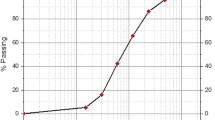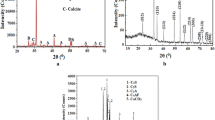Abstract
The utilization of nanoparticle-blended cement while producing concrete or mortar is gaining immense significance nowadays, mainly on account of the improvements in the long-term durability characteristics of the composites. The feasibility of using cement blended with nano-\(\hbox {TiO}_{2}\) particles to produce less permeable or impermeable mortar and concrete of sufficient strength and durability requirements was investigated in the present study. The composite cement includes Ordinary Portland Cement replaced with \(\hbox {TiO}_{2}\) nanoparticles at 0%, 2%, 4%, 6%, 8% and 10% quantities by weight. The properties studied include heat of hydration, compressive strength, bond strength, water absorption, permeability and sorptivity of mortar or concrete specimens. The roughness and surface defects of coarse aggregates greatly alleviated due to the incorporation of nano-\(\hbox {TiO}_{2}\) particles in concrete specimens. The rate of heat evolution increased during early stages of hydration owing to the high fineness and additional reactive surfaces induced from the nano-\(\hbox {TiO}_{2}\) particles blended in cementitious composite. Additionally, with reference to strength and durability characteristics, the nano-\(\hbox {TiO}_{2}\)-blended composites performed relatively better than the control samples. The role of blended nano-\(\hbox {TiO}_{2}\) cement composites in reducing the interconnected matrix porosity of concrete is discussed briefly, providing evidences from scanning electron microscope (SEM) observations.










Similar content being viewed by others
References
Sanchez F and Sobolev K 2010 Nanotechnology in concrete—a review. Constr. Build. Mater. 24(11): 2060–2071 https://doi.org/10.1016/j.conbuildmat.2010.03.014
Jo B W, Kim C H, Tae G and Park J B 2007 Characteristics of cement mortar with nano-\(\text{ SiO}_{2}\) particles. Constr. Build. Mater. 21(6): 1351–1355 https://doi.org/10.1016/j.conbuildmat.2005.12.020
Norhasri M S M, Hamidah M S and Fadzil A M 2017 Applications of using nano material in concrete: a review. Constr. Build. Mater. 133: 91–97 https://doi.org/10.1016/j.conbuildmat.2016.12.005
Reches Y 2018 Nanoparticles as concrete additives: review and perspectives. Constr. Build. Mater. 175: 483–495 https://doi.org/10.1016/j.conbuildmat.2018.04.214
Li G 2004 Properties of high-volume fly ash concrete incorporating nano-\(\text{ SiO}_{2}\). Cem. Concr. Res. 34(6): 1043–1049 https://doi.org/10.1016/j.cemconres.2003.11.013
Du H, Du S and Liu X 2014 Durability performances of concrete with nano-silica. Constr. Build. Mater. 73: 705–712 https://doi.org/10.1016/j.conbuildmat.2014.10.014
Nazari A, Riahi S, Riahi S, Shamekhi S F and Khademno A 2010 Influence of \(\text{ Al}_{2}\text{ O}_{3}\) nanoparticles on the compressive strength and workability of blended concrete. J. Am. Sci. 6(5): 6–9
Sato T and Beaudoin J 2011 Effect of nano-\(\text{ CaCO}_{3}\) on hydration of cement containing supplementary cementitious materials. Adv. Cem. Res. 23(1): 33–43 https://doi.org/10.1680/adcr.9.00016
Said A M, Zeidan M S, Bassuoni M T and Tian Y 2012 Properties of concrete incorporating nano-silica. Constr. Build. Mater. 36: 838–844 https://doi.org/10.1016/j.conbuildmat.2012.06.044
Staub de Melo J V and Trichłs G 2018 Study of the influence of nano-\(\text{ TiO}_{2}\) on the properties of Portland cement concrete for application on road surfaces. Road Mater. Pavement Des. 19(5): 1011–1026 https://doi.org/10.1080/14680629.2017.1285811
Khoshakhlagh A, Nazari A and Khalaj G 2012 Effects of \(\text{ Fe}_{2}\text{ O}_{3}\) nanoparticles on water permeability and strength assessments of high strength self-compacting concrete. J. Mater. Sci. Technol. 28(1): 73–82 https://doi.org/10.1016/S1005-0302(12)60026-7
Fan Y, Zhang S, Wang Q and Shah S P 2015 Effects of nano-kaolinite clay on the freeze–thaw resistance of concrete. Cem. Concr. Compos. 62: 1–12 https://doi.org/10.1016/j.cemconcomp.2015.05.001
Folli A 2011 TiO2 photocatalysis in Portland cement systems: fundamentals of self cleaning effect and air pollution mitigation. Ph.D. Thesis, University of Aberdeen, Scotland
Qin Z B, Zhang W T, Qian G P, Wu X L and Li Y 2015 The effects of different ways of adding nano-\(\text{ TiO}_{2}\) to concrete on the degradation performance of \(\text{ NO}_{2}\). Mater. Res. Innovations 19(10): 148–154 https://doi.org/10.1179/1432891715Z.0000000002127
Maggos T, Plassais A, Bartzis J G, Vasilakos C, Moussiopoulos N and Bonafous L 2008 Photocatalytic degradation of NO\(_{x}\) in a pilot street canyon configuration using \(\text{ TiO}_{2}\)-mortar panels. Environ. Monit. Assess. 136(1–3): 35–44 https://doi.org/10.1007/s10661-007-9722-2
Nazari A and Riahi S 2011 \(\text{ TiO}_{2}\) nanoparticles effects on properties of concrete using ground granulated blast furnace slag as binder. Sci. China Technol. Sci. 54(11): 3109 https://doi.org/10.1007/s11431-011-4421-1
Chen J, Kou S C and Poon C S 2012 Hydration and properties of nano-\(\text{ TiO}_{2}\) blended cement composites. Cem. Concr. Compos. 34(5): 642–649 https://doi.org/10.1016/j.cemconcomp.2012.02.009
Meng T, Yu Y, Qian X, Zhan S and Qian K 2012 Effect of nano-\(\text{ TiO}_{2}\) on the mechanical properties of cement mortar. Constr. Build. Mater. 29: 241–245 https://doi.org/10.1016/j.conbuildmat.2011.10.047
Feng D, Xie N, Gong C, Leng Z, Xiao H, Li H and Shi X 2013 Portland cement paste modified by \(\text{ TiO}_{2}\) nanoparticles: a microstructure perspective. Ind. Eng. Chem. Res. 52(33): 11575–11582 https://doi.org/10.1021/ie4011595
Ma B, Li H, Mei J, Li X and Chen F 2015 Effects of nano-\(\text{ TiO}_{2}\) on the toughness and durability of cement-based material. Adv. Mater. Sci. Eng. 2015: 583106 https://doi.org/10.1155/2015/583106
Zhang R, Cheng X, Hou P and Ye Z 2015 Influences of nano-\(\text{ TiO}_{2}\) on the properties of cement-based materials: hydration and drying shrinkage. Constr. Build. Mater. 81: 35–41 https://doi.org/10.1016/j.conbuildmat.2015.02.003
Duan P, Yan C, Luo W and Zhou W 2016 Effects of adding nano-\(\text{ TiO}_{2}\) on compressive strength, drying shrinkage, carbonation and microstructure of fluidized bed fly ash based geopolymer paste. Constr. Build. Mater. 106: 115–125 https://doi.org/10.1016/j.conbuildmat.2015.12.095
Li Z, Ding S, Yu X, Han B and Ou J 2018 Multifunctional cementitious composites modified with nano titanium dioxide: a review. Compos. Part A: Appl. Sci. Manuf. 111: 115–137 https://doi.org/10.1016/j.compositesa.2018.05.019
Rhee I, Lee J S, Kim J B and Kim J H 2018 Nitrogen oxides mitigation efficiency of cementitious materials incorporated with \(\text{ TiO}_{2}\). Materials 11(6): 877 https://doi.org/10.3390/ma11060877
Silvestre J, Silvestre N and de Brito J 2016 Review on concrete nanotechnology. Eur. J. Environ. Civ. Eng. 20(4): 455–485 https://doi.org/10.1080/19648189.2015.1042070
Sobolev K 2016 Modern developments related to nanotechnology and nano engineering of concrete. Front. Struct. Civ. Eng. 10(2): 131–141 https://doi.org/10.1007/s11709-016-0343-0
Han B, Zhang L, Zeng S, Dong S, Yu X, Yang R and Ou J 2017 Nano-core effect in nano-engineered cementitious composites. Compos. Part A: Appl. Sci. Manuf. 95: 100–109 https://doi.org/10.1016/j.compositesa.2017.01.008
Lau D, Jian W, Yu Z and Hui D 2018 Nano-engineering of construction materials using molecular dynamics simulations: prospects and challenges. Compos. B: Eng. 143: 282–291 https://doi.org/10.1016/j.compositesb.2018.01.014
IS:8112-2013 2013 Ordinary Portland cement, 43 grade – specifications. Bureau of Indian Standards, New Delhi
IS:383-1970 2002 Specification for coarse and fine aggregates from natural sources for concrete. Bureau of Indian Standards, New Delhi
IS:10262-2009 2009 Guidelines for concrete mix design proportioning. Bureau of Indian Standards, New Delhi
IS:4031 (Part-6)-1988 2005 Determination of compressive strength of hydraulic cement (other than masonry cement). Methods of physical tests for hydraulic cement, part 6. New Delhi: Bureau of Indian Standards
IS:4031 (Part-4)-1988 2005 Determination of consistency of standard cement paste. Methods of physical tests for hydraulic cement, part 4. New Delhi: Bureau of Indian Standards
IS:4031 (Part-5)-1988 2005 Determination of initial and final setting times. Methods of physical tests for hydraulic cement, part 5. New Delhi: Bureau of Indian Standards
IS:1199-1959 1991 Methods of sampling and analysis of concrete. Bureau of Indian Standards, New Delhi
IS:11262-1985 1985 Specification for calorimeter for determination of heat of hydration of hydraulic cement. Bureau of Indian Standards, New Delhi
IS:4031 (Part-9)-1988 2005 Determination of heat of hydration. Methods of physical tests for hydraulic cement, part 9. New Delhi: Bureau of Indian Standards
IS:516-1959 2006 Method of tests for strength of concrete. Bureau of Indian Standards, New Delhi
BS 1881:Part 122:1983 1983 Testing concrete: method for determination of water absorption. British Standards Institution, London
ASTM C 1585-13 2013 Standard test method for measurement of rate of absorption of water by hydraulic-cement concretes. ASTM International, PA
Hall C 1989 Water sorptivity of mortars and concretes: a review. Mag. Concr. Res. 41: 51–61 https://doi.org/10.1680/macr.1989.41.147.51
IS:3085-1965 2002 Methods of test for permeability of cement mortar and concrete. Bureau of Indian Standards, New Delhi
Kunther W, Ferreiro S and Skibsted J 2017 Influence of the Ca/Si ratio on the compressive strength of cementitious calcium-silicate-hydrate binders. J. Mater. Chem. A 5(33): 17401–17412 https://doi.org/10.1039/C7TA06104H
Rossen J E, Lothenbach B and Scrivener K 2015 Composition of CSH in pastes with increasing levels of silica fume addition. Cem. Concr. Res. 75: 14–22 https://doi.org/10.1016/j.cemconres.2015.04.016
Acknowledgements
The authors wish to acknowledge the cooperation rendered by the non-teaching staff of Department of Civil Engineering, SMVITM, Bantakal, in obtaining the experimental data presented in the manuscript.
Author information
Authors and Affiliations
Corresponding author
Rights and permissions
About this article
Cite this article
Naganna, S.R., Jayakesh, K. & Anand, V.R. Nano-TiO2 particles: a photocatalytic admixture to amp up the performance efficiency of cementitious composites. Sādhanā 45, 280 (2020). https://doi.org/10.1007/s12046-020-01515-x
Received:
Revised:
Accepted:
Published:
DOI: https://doi.org/10.1007/s12046-020-01515-x




